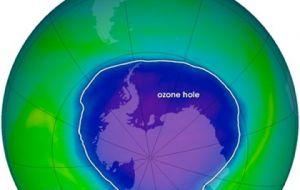MercoPress. South Atlantic News Agency
UV alert in Punta Arenas as ozone-hole advances to the continent
 Ozone hole over the Antarctic continent
Ozone hole over the Antarctic continent Magallanes University Ozone Monitoring Laboratory has detected for the second time this year a considerable advance of the Antarctic Ozone Hole over this region in the extreme south of Chile.
The size of the Antarctic Ozone Hole this time of the year has an elongated shape moving from the centre of the Antarctic continent towards the Magallanes region, with its effects having reached the outskirts of Punta Arenas warns the Ozone monitoring lab.
This has had an immediate impact on the ultra violet radiation which during the first days of October has remained in the range of 4 to 5, considered moderate and “acceptable”.
However Claudia Casiccia, head of the Ozone monitoring lab warns that this was mainly because of the extremely cloudy weather.
“But with a clear sky the index jumps to 6 and 7, which means local residents must take precautionary measures such as long sleeves, wide hats, sun glasses and solar protection factor 15 minimum”, said Ms Casiccia.
“Children, toddlers, infants and the vulnerable population must avoid exposition to the sun”, she added.
Meantime an ozone-sounder with sensors was released from the lab to measure the ozone concentration at different altitudes over Magallanes region.




Top Comments
Disclaimer & comment rulesCommenting for this story is now closed.
If you have a Facebook account, become a fan and comment on our Facebook Page!